Last Chance: The Annual Orchid Show Soars at the New York Botanical Garden
The vibrant colors of Mexico come to NYC for a unique Orchid Show at NYBG!


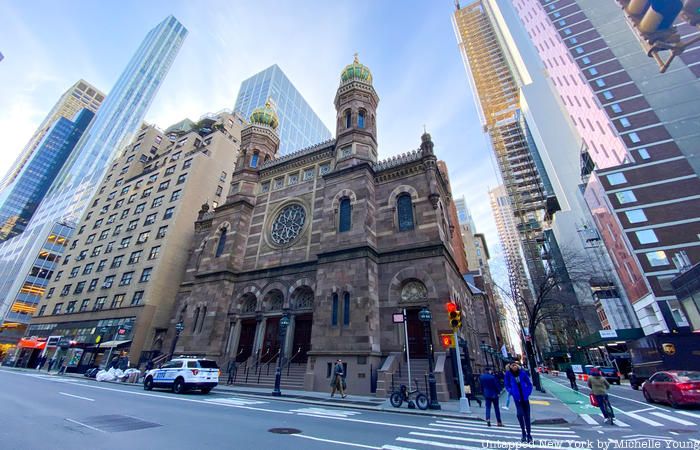
To people today, it may seem incongruous that a synagogue was designed in the Moorish Revival style, with inspiration from Islamic architecture. But, “it was the hot architecture of the time,” Goldberger told us on the tour. Moorish Revival was popularized in Jewish architecture in Europe from 1830 through the rest of the 19th century, and made its way over to the States.
The Landmarks Preservation Commission designation report for Central Synagogue proclaims it the “finest extant example of the Moorish Revival style in New York City, that it is boldly distinctive in style, striking in appearance and that it contains unusual architectural details.”
In conjunction with an exhibition at the Museum at Eldridge Street, whose synagogue also has distinct Moorish influences, a museum staffer writes that the architectural style has surprisingly complex roots. Beyond what is commonly assumed, that Jewish congregations were paying homage to a Golden Age of Jewish culture within Moorish Spain, anthropologist Ivan Davidson Kalmar, argues in a journal for Indiana University Press that the decision by Jews to utilize Moorish architecture was in fact a deliberate move to embrace their own “otherness.”
Kalmar writes, “During the period when Moorish-style synagogues were built, the Jews were considered by others and by themselves as the Orientals of the West. They hoped to make Orientalist idealizations of themselves prevail over the Orientalist vituperations. Rather than rejecting the East-West dichotomy, and the rhetoric of race, they bought into it. They hoped that they could convince the public of the nobility of their Oriental blood-and sometimes they did. The Moorish-style synagogue was an expression of their quest.”x
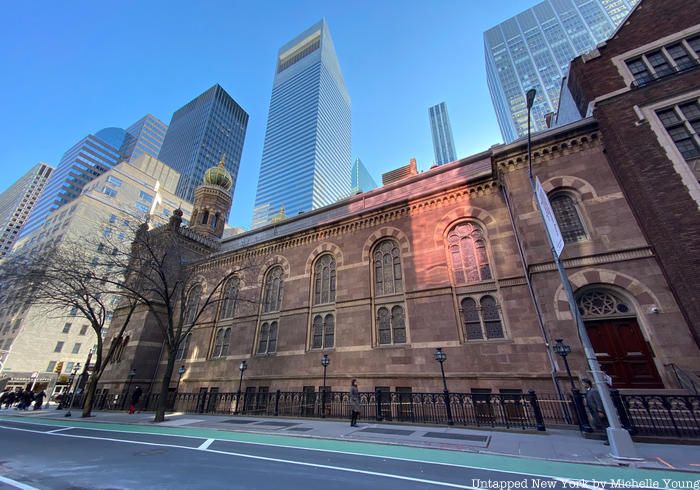
Despite Islamic and Moorish influences, Central Synagogue is also distinctly Western, particularly in terms of its materials. If the exterior stone feels quite New York, it’s because it’s made of brownstone quarried from Belleville, New Jersey just north of Newark! New Jersey Department of Environmental Protection calls brownstone the “unofficial state rock” and it “came to epitomize luxury and architectural sophistication” when it was widely used in the 18th and 19th centuries.
The Belleville quarries in the Passaic formation were the most productive “supplying more material for brownstone fronts of houses than any other source in the country,” according to the New Jersey DEP. The stone dates back to the days of the dinosaurs in the late Triassic and early Jurassic period. The lighter trim color on the facade of Central Synagogue is of Ohio sandstone.
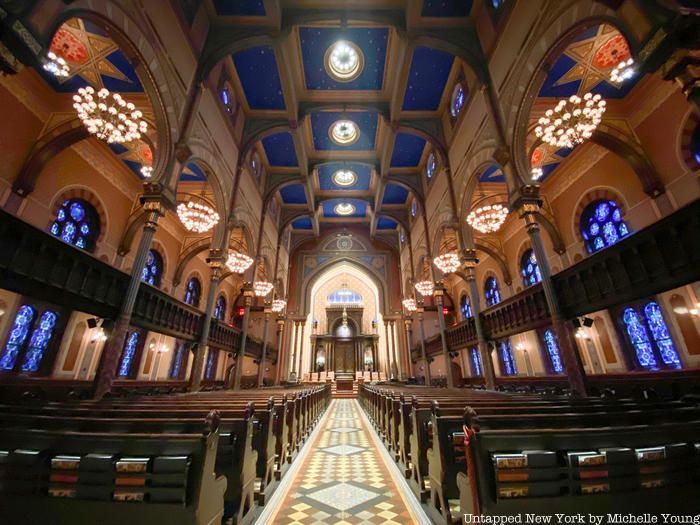
Synagogues are usually oriented to face Jerusalem, so in New York City, the prevailing direction should be east. However, Central Synagogue faces west. Like all things New York City, this was a real estate decision. “We wanted that plot of land,” says Goldberger. There may have been pressure from the construction of Temple Emanu-El, an impressive Moorish style synagogue which was located at 43rd and 5th Avenue, also designed by Fernbach. The surrounding area near the future Central Synagogue site had a sizable German-speaking population, so the synagogue hedged its bets.
The real estate deal was too hard to turn down and it was determined that it would be best to still keep the entrance along Lexington Avenue. And so, the ark was put on the east wall with the congregants facing west. “We towered over everything that was in this neighborhood. Clearly, we no longer tower over anything,” jokes Goldberger.
The reverse orientation of the synagogue is just one among several elements that makes Central Synagogue part of the Jewish reform movement. In the early days of the synagogue, services were done in German and were shortened to make it more accessible to the local population, and later services were conducted in English. The traditional separation between the clergy and congregants was removed and the pews in the front section of the synagogue are angled 45 degrees towards the front to provide a greater sense of community. In the last ten to fifteen years, another shift has taken place where Hebrew is spoken in the prayers and blessings.
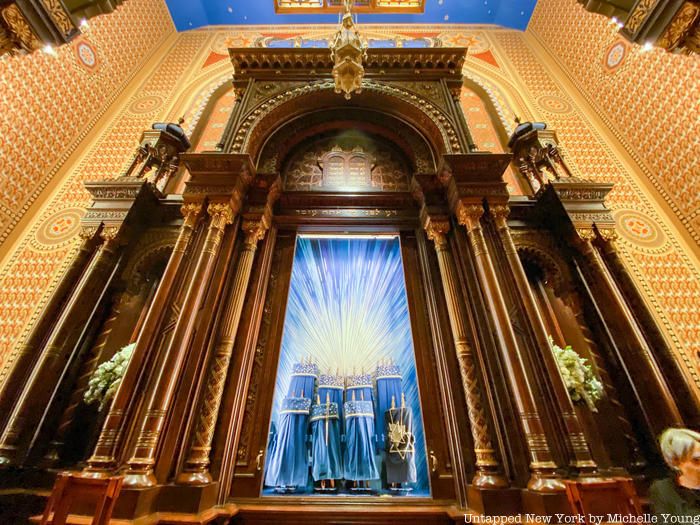
The ark of Central Synagogue is something to behold. It’s the original ark of the synagogue and designed by Fernbach, who took on both the commission for the building and its interior design. The ark was made by the Pottier & Stymus Co. in New York, and managed to survive a devastating fire that tore through the synagogue on August 28, 1998. Inside the ark, there are multiple torahs, including a very special one.
In 1967, Central Synagogue was given a Torah that was part of a collection of over 1500 Sefer Torahs that were collected by the Nazis in Prague from Jewish communities in Bohemia, Moravia and Slovakia. Incredibly, they were not destroyed because the Nazis had intended to create an exhibition in the Jewish Quarter that would show the relics of the race they had decimated. Before being deported to concentration camps, Jewish prisoners in Prague meticulously cataloged and tagged the relics, which included not only torahs but also books, manuscripts, and religious objects. After the war, the torahs came under the authority of the Czech government, and in 1964, the scrolls were transferred to the Westminster Synagogue which subsequently distributed the scrolls around the world on permanent loan. Central Synagogue has Torah number 866 which came originally from Lipnik, Czechoslovakia. It sits on the right side, with a Star of David on it.
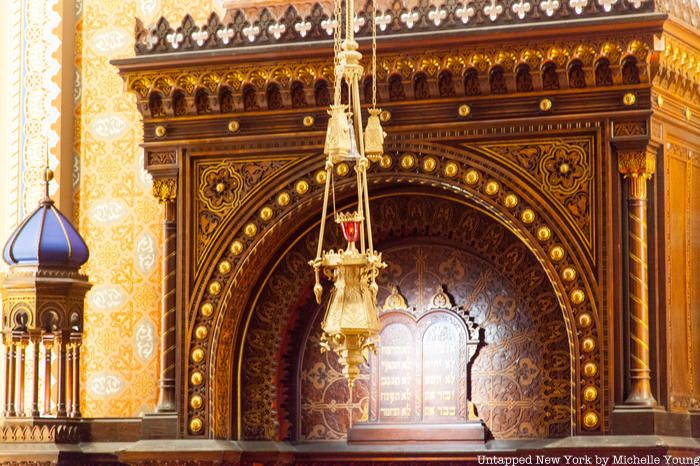
Pottier & Stymus Co., which made the ark and other woodwork in Central Synagogue was a nationally-renown company. Its factory was just nearby on 42nd Street and Lexington Avenue and the company made furniture for the White House including furniture for President Ulysses S. Grant’s office, the conference table in the Cabinet room, along with furniture for the Secretary of the Treasury’s office.
Auguste Pottier was born in France and came to the United States in 1847 at around the age of 23. He worked in various furniture making companies in New York until founding his own firm with William P. Stymus. The company also did work for Thomas Edison‘s estate, the grand mansion of Henry Flagler in Palm Beach, Florida, and Leland Stanford, among other important Americans of the era. Today you can see Pottier’s work also in the Metropolitan Museum of Art.
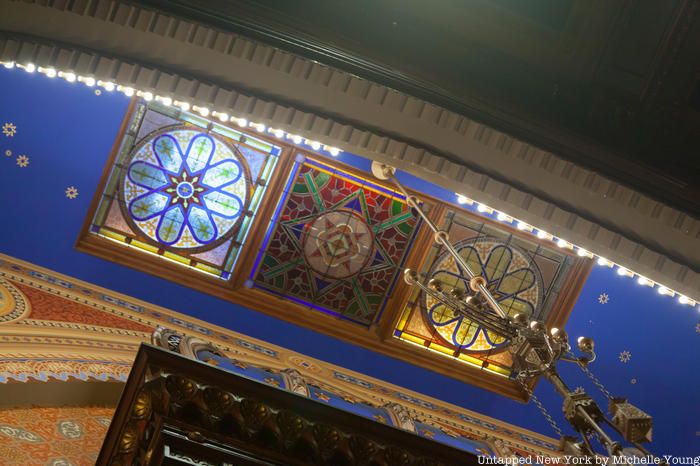
Most of the original stained glass in Central Synagogue was replaced in the 1940s and 1970s or destroyed in the 1998 fire, but there are a few pieces remaining if you know where to look. First, there are three pieces above the ark. They had been covered up in World War II to avoid the building being targeted in air raids, much like other buildings with glass details such as the original Penn Station, the Ansonia Hotel, even the skylights of the now-decommissioned City Hall subway station. These three six-foot square stained glass pieces in Central Synagogue were rediscovered in a restoration. Another section of original stained glass is located in the stairwell between the ground level of the sanctuary and the balcony.
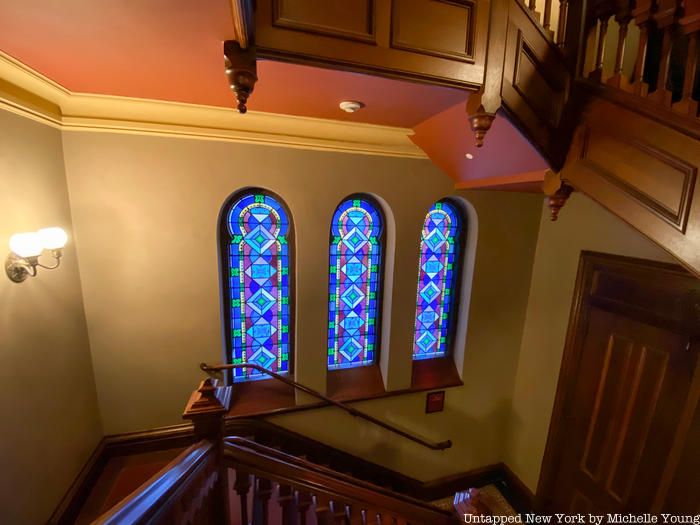
In the restoration after the fire, the northeast roundel in the sanctuary was recreated from glass salvaged from the fire and then dedicated to the firemen who saved the building. The main rose window, though not original to 1872, did survive the fire, with the firemen expertly piercing a hole through the center in order to get a hose through. “We were very, very lucky with the firefighters,” says Goldberger, “because they were very respectful. Our neighbors were so nice and allowed the firefighters on their balconies to shoot water [onto the synagogue].”
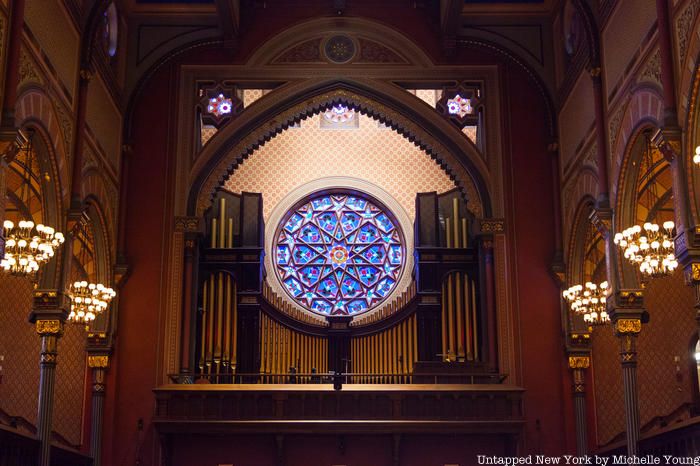
Another unusual element of the synagogue is the inclusion of an organ, the third to sit in this location. “The organ is very much a part of the reform movement,” says Goldberger. This particular organ was installed in the restoration following the fire. It was a gift from congregants in honor of their father, Gabe M. Wiener and was made by the firm Casavant Frères of St. Hyacinthe, Canada. It’s actually two separate instruments put together. In total, there are 4,345 pipes, 55 stops, and 74 ranks. As the synagogue describes, one is the “Bimah Organ (Casavant Opus 3812) located alongside the bimah and used primarily during services to accompany the cantor, choir, and congregation; and a larger Gallery Organ (Casavant Opus 3813) located in the elevated rear choir loft and used both for services and concerts.”
The organ also has two special stops that were custom made for Central Synagogue, a “Trompette Shofar,” that mimics the sound of a traditional shofar and is used for services on Rosh Hashanah and Yom Kippur. Another is the “Klezmer Clarinette,” that that sounds like that instrument, believed to be the first of its kind in an organ. The sound of the organ is delivered through a custom-designed sound system.
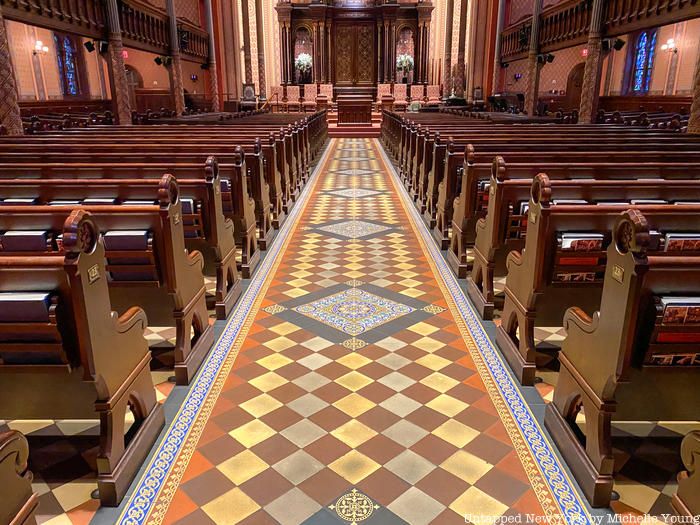
The extent of the fire at Central Synagogue cannot be overstated. The fire was in the center of the building and the roof ended up caving in. There was extensive fire damage and water damage from the rescue effort. Fortunately, Central Synagogue still had the blueprints from 1870 and used them to rebuild. It took longer to restore the place than it took to build it originally from the ground up.
One stroke of good luck was that the company that made the Victorian-style encaustic floor tiles is still in operation in England (operated by a successor company). The synagogue ordered 40,000 new tiles to replace the ones damaged in the fire.
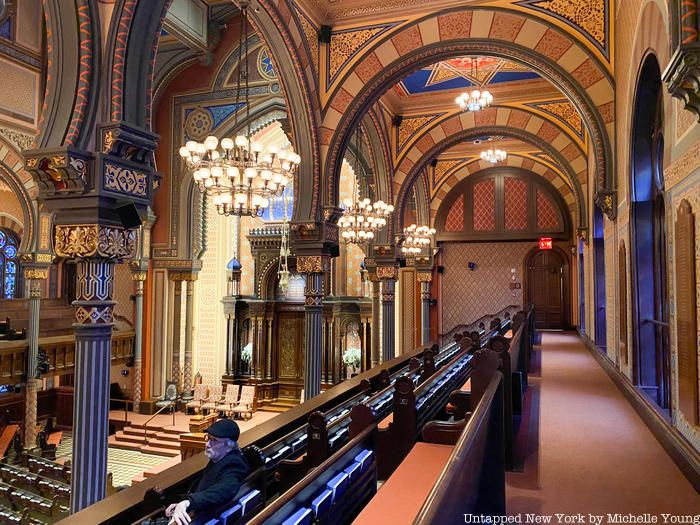
Most of the pillars in the synagogue are made of cast-iron, a material that had just recently been introduced for religious architecture. Two of the columns on each side of the sanctuary look identical to the rest, but are just made of wood. That’s because they are purely visual — added to make the sanctuary appear longer but have no structural purpose.
In contrast, the cast-iron pillars go all the way down to the bedrock and support the height of the interior structure.
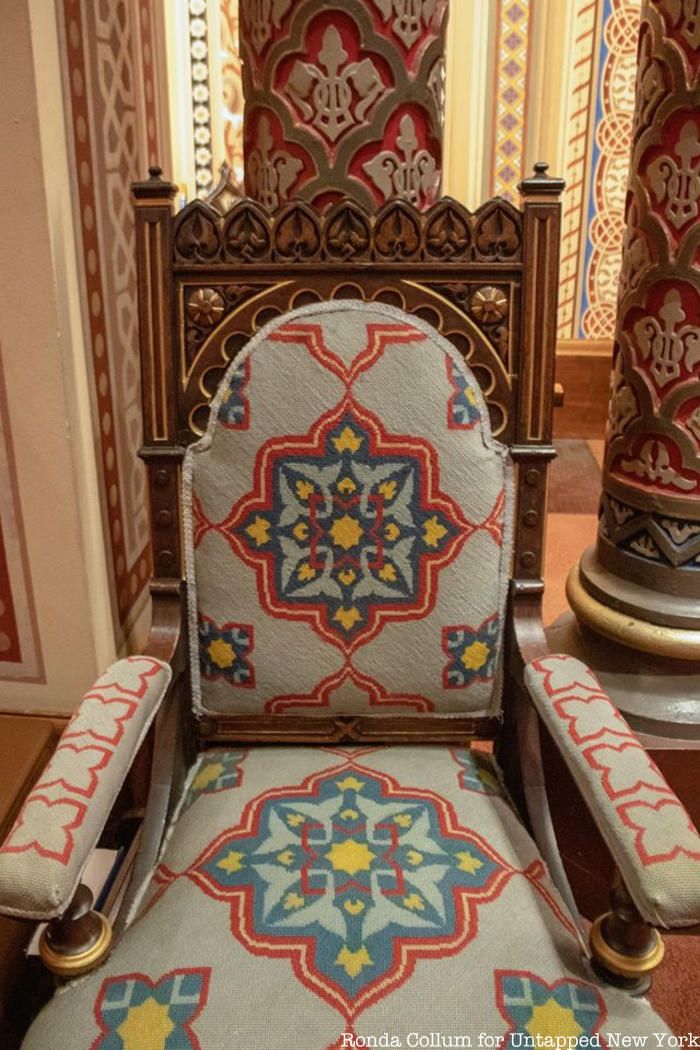
Originally, the bimah had four armchairs that were designed by Fernbach and matched the ornateness of the rest of the synagogue interior. As described by one of the synagogue’s archivist Anne Mininberg, who also accompanied our tour, “The carving on the crest rail of the chairs replicates the designs surrounding their setting on the bimah. The alternating interlaced leaf pattern directly relates to the motifs on the cast-iron columns of the bimah arch, the carving on the wood ark columns and on the ark doors.”
In 2009, three of the four chairs were gifted to different museums, one to the Metropolitan Museum of Art, one to the American Museum of Jewish History in Philadelphia; and one to Yeshiva University Museum in New York. The last one remains on the bimah as a testament to the original.
Check out our next explorations for Untapped New York Insiders!
Subscribe to our newsletter